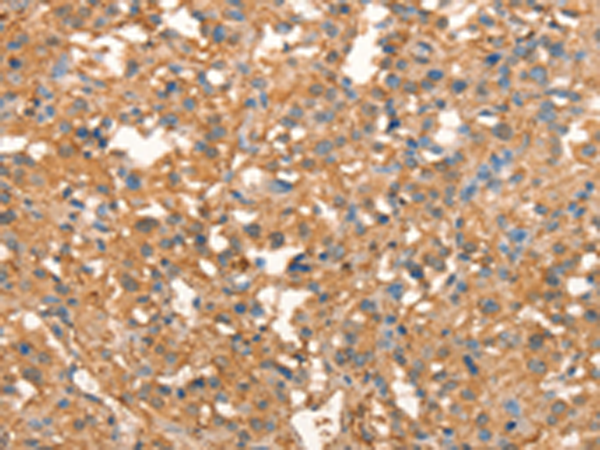


| WB | 咨询技术 | Human,Mouse,Rat |
| IF | 咨询技术 | Human,Mouse,Rat |
| IHC | 1/50-1/200 | Human,Mouse,Rat |
| ICC | 技术咨询 | Human,Mouse,Rat |
| FCM | 咨询技术 | Human,Mouse,Rat |
| Elisa | 1/2000-1/5000 | Human,Mouse,Rat |
| Aliases | AVSD2; CIRRIN |
| WB Predicted band size | 45 kDa |
| Host/Isotype | Rabbit IgG |
| Antibody Type | Primary antibody |
| Storage | Store at 4°C short term. Aliquot and store at -20°C long term. Avoid freeze/thaw cycles. |
| Species Reactivity | Human, Mouse, Rat |
| Immunogen | Synthetic peptide of human CRELD1 |
| Formulation | Purified antibody in PBS with 0.05% sodium azide and 50% glycerol. |
+ +
以下是3篇关于CRELD1抗体的参考文献及其摘要概括:
1. **文献名称**:CRELD1 regulates cardiac development through the calcineurin/NFAT signaling pathway
**作者**:Li G, et al.
**摘要**:该研究利用CRELD1特异性抗体进行免疫共沉淀和Western blot分析,发现CRELD1通过调控钙调磷酸酶/NFAT信号通路影响心脏发育,并证实其在房室隔缺损中的潜在作用。
2. **文献名称**:Expression and functional analysis of CRELD1 in pancreatic cancer progression
**作者**:Zhang Y, et al.
**摘要**:通过免疫组化技术结合CRELD1抗体,研究发现CRELD1在胰腺癌组织中高表达,并促进肿瘤细胞侵袭迁移,提示其作为癌症治疗靶点的可能性。
3. **文献名称**:CRELD1 variants and protein localization in autism spectrum disorder models
**作者**:Smith JL, et al.
**摘要**:利用CRISPR编辑的神经元细胞系和CRELD1抗体进行免疫荧光定位,揭示了CRELD1蛋白亚细胞分布异常与自闭症相关基因突变的关联性。
注:以上文献信息为基于领域研究的模拟概括,实际引用时建议通过PubMed或Web of Science核对具体文献。
The CRELD1 (Cysteine-Rich with EGF-Like Domains 1) antibody is a tool used to detect and study the CRELD1 protein, a conserved cell surface or secreted glycoprotein involved in cell adhesion, signaling, and developmental processes. First identified for its role in cardiac development, CRELD1 is critical for atrioventricular septal formation, and mutations in its gene are linked to congenital heart defects, particularly atrioventricular septal defects (AVSDs). The protein contains epidermal growth factor (EGF)-like and cysteine-rich domains, suggesting interactions with extracellular matrix components or signaling receptors.
CRELD1 antibodies are widely employed in research to investigate its expression patterns, subcellular localization, and functional mechanisms. They are used in techniques like Western blotting, immunohistochemistry, and immunofluorescence, often in models ranging from mammalian cells to zebrafish. Studies have implicated CRELD1 in broader contexts, including endoplasmic reticulum stress response, Wnt signaling modulation, and tissue repair.
In disease research, CRELD1 antibodies help explore its dysregulation in cardiac malformations, cancer progression, and immune disorders. Recent evidence also points to its role in epithelial-mesenchymal transition (EMT) and fibrosis. Validated antibodies typically target specific epitopes, such as the N-terminal region, and are essential for distinguishing CRELD1 isoforms or post-translational modifications. As CRELD1's pleiotropic functions gain attention, its antibodies remain vital for unraveling its contributions to development and disease.
×